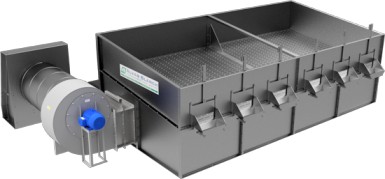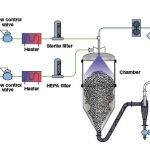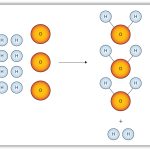The following are descriptions of various types of batch dryers.
Tray dryers. This dryer type operates by passing hot air over the surface of a wet solid that is spread over trays arranged in racks. Tray dryers are the simplest and least-expensive dryer type. This type is most widely used in the food and pharmaceutical industries. The chief advantage of tray dryers, apart from their low initial cost, is their versatility. With the exception of dusty solids, materials of almost any other physical form may be dried. Drying times are typically long (usually 12 to 48 h).
Vacuum dryers. Vacuum dryers offer low-temperature drying of thermolabile materials or the recovery of solvents from a bed. Heat is usually supplied by passing steam or hot water through hollow shelves. Drying temperatures can be carefully controlled and, for the major part of the drying cycle, the solid material remains at the boiling point of the wetting substance. Drying times are typically long (usually 12 to 48 h).
For more on vacuum drying, see Batch Drying with Vacuum Contact Dryers
Fluidized-bed dryers. A gas-fluidized bed may have the appearance of a boiling liquid. It has bubbles, which rise and appear to burst. The bubbles result in vigorous mixing. A preheated stream of air enters from the bottom of the product container holding the product to be dried and fluidizes it. The resultant mixture of solids and gas behave like a liquid, and thus the solids are said to be fluidized. The solid particles are continually caught up in eddies and fall back in a random boiling motion so that each fluidized particle is surrounded by the gas stream for efficient drying, granulation or coating purposes. In the process of fluidization, intense mixing occurs between the solids and air, resulting in uniform conditions of temperature, composition and particle size distribution throughout the bed.
Freeze dryers. Freeze-drying is an extreme form of vacuum drying in which the water or other solvent is frozen and drying takes place by subliming the solid phase. Freeze-drying is extensively used in two situations: (1) when high rates of decomposition occur during normal drying; and (2) with substances that can be dried at higher temperatures, and that are thereby changed in some way.
Microwave vacuum dryers. High-frequency radio waves with frequencies from 300 to 30,000 MHz are utilized in microwave drying (2,450 MHz is used in batch microwave processes). Combined microwave-convective drying has been used for a range of applications at both laboratory and industrial scales. The bulk heating effect of microwave radiation causes the solvent to vaporize in the pores of the material. Mass transfer is predominantly due to a pressure gradient established within the sample. The temperature of the solvent component is elevated above the air temperature by the microwave heat input, but at a low level, such that convective and evaporative cooling effects keep the equilibrium temperature below saturation. Such a drying regime is of particular interest for drying temperature-sensitive materials. Microwave-convective processing typically facilitates a 50% reduction in drying time, compared to vacuum drying.
CONTINUOUS DRYERS
Continuous dryers are mainly used in chemical and food industries, due to the large volume of product that needs to be processed. Most common are continuous fluid-bed dryers and spray dryers. There are other dryers, depending on the product, that can be used in certain industries — for example, rotary dryers, drum dryers, kiln dryers, flash dryers, tunnel dryers and so on. Spray dryers are the most widely used in chemical, dairy, agrochemical, ceramic and pharmaceutical industries.
Spray dryer. The spray-drying process can be divided into four sections: atomization of the fluid, mixing of the droplets, drying, and, removal and collection of the dry particles (Figure 2). Atomization may be achieved by means of single-fluid or two-fluid nozzles, or by spinning-disk atomizers. The flow of the drying gas may be concurrent or countercurrent with respect to the movement of droplets. Good mixing of droplets and gas occurs, and the heat- and mass-transfer rates are high. In conjunction with the large interfacial area conferred by atomization, these factors give rise to very high evaporation rates. The residence time of a droplet in the dryer is only a few seconds (5–30 s). Since the material is at wet-bulb temperature for much of this time, high gas temperatures of 1,508 to 2,008C may be used, even with thermolabile materials. For these reasons, it is possible to dry complex vegetable extracts, such as coffee or digitalis, milk products, and other labile materials without significant loss of potency or flavor. The capital and running costs of spray dryers are high, but if the scale is sufficiently large, they may provide the cheapest method.
For more on spray drying see Optimizing Analysis for Spray-Drying https://www.chemengonline.com/optimizing-analysis-for-spray-drying/

Figure 2. Spray dryers have high capital and operating costs, but can be the least expensive method at large scales
DRYER EFFICIENCY
With increasing concern about environmental degradation, it is desirable to decrease energy consumption in all sectors. Drying has been reported to account for anywhere from 12 to 20% of the energy consumption in the industrial sector. Drying processes are one of the most energy-intensive unit operations in the CPI.
One measure of efficiency is the ratio of the minimum quantity of heat that will remove the required water to the energy actually provided for the process. Sensible heat can also be added to the minimum, as this added heat in the material often cannot be economically recovered. Other newer technologies have been developed, such as sonic drying, superheated steam, heat-pump-assisted drying and others.


